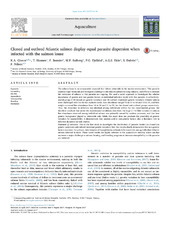| dc.contributor.author | Glover, Kevin | |
| dc.contributor.author | Hansen, Tom Johnny | |
| dc.contributor.author | Besnier, Francois | |
| dc.contributor.author | Solberg, Monica Favnebøe | |
| dc.contributor.author | Fjelldal, Per Gunnar | |
| dc.contributor.author | Sørvik, Anne Grete Eide | |
| dc.contributor.author | Dalvin, Sussie | |
| dc.contributor.author | Nilsen, Frank | |
| dc.date.accessioned | 2017-12-19T09:00:00Z | |
| dc.date.available | 2017-12-19T09:00:00Z | |
| dc.date.issued | 2017-11 | |
| dc.Published | Glover KA, Hansen TJ, Besnier F, Solberg MF, Fjelldal PG, Sørvik AGE, Dalvin ST, Nilsen F. Cloned and outbred Atlantic salmon display equal parasite dispersion when infected with the salmon louse. Aquaculture. 2017;480:83-88 | eng |
| dc.identifier.issn | 1873-5622 | en_US |
| dc.identifier.issn | 0044-8486 | en_US |
| dc.identifier.uri | https://hdl.handle.net/1956/17031 | |
| dc.description.abstract | The salmon louse is an ectoparasitic copepod that infects salmonids in the marine environment. This parasite causes a major economic and biological challenge to the Atlantic salmon farming industry, and efforts to increase the resistance of salmon to this parasite are ongoing. We used a novel approach to investigate the relative importance of genetic and non-genetic factors on individual infection levels with this parasite. A collectively-reared group of 50 cloned (no genetic variation) and 50 outbred (maximum genetic variation) Atlantic salmon were challenged with lice in two replicate tanks. Lice abundance ranged from 19 to 58 and 13 to 50, and fish-weight corrected lice abundance from 16 to 56 and 11 to 50, for the cloned and outbred groups respectively. Thus, the dispersion in infection was identical among individuals within the two experimental groups. We therefore conclude that under the experimental conditions described, the large (> 5-fold) variation in salmon lice abundance observed among individual salmon was primarily caused by random processes, and that host genetic background played no detectable role. While this result does not preclude the possibility of genetic variation for susceptibility, it demonstrates that random and/or non-genetic factors play a dominant role in infection dynamics in tank studies. Statement of relevance This is the first study to investigate the distribution of parasite burden on cloned (no genetic variation) and outbred (maximal genetic variation) fish. Our results clearly demonstrate that non-genetic factors represent the primary determinants of Lepeophtheirus salmonis infection-levels among individual Atlantic salmon infected in tanks. These novel results are highly relevant to the aquaculture industry where sea lice represent a major challenge to salmon farming, and breeding programs to decrease susceptibility to this parasite are initiated. | en_US |
| dc.language.iso | eng | eng |
| dc.publisher | Elsevier | en_US |
| dc.rights | Attribution CC BY-NC-ND | eng |
| dc.rights.uri | http://creativecommons.org/licenses/by-nc-nd/4.0/ | eng |
| dc.subject | Heritability | eng |
| dc.subject | Sea lice | eng |
| dc.subject | Aquaculture | eng |
| dc.subject | Microsatellite | eng |
| dc.subject | Breeding | eng |
| dc.subject | Resistance | eng |
| dc.title | Cloned and outbred Atlantic salmon display equal parasite dispersion when infected with the salmon louse | en_US |
| dc.type | Peer reviewed | |
| dc.type | Journal article | |
| dc.date.updated | 2017-11-29T14:49:12Z | |
| dc.description.version | publishedVersion | en_US |
| dc.rights.holder | Copyright 2017 The Author(s) | en_US |
| dc.identifier.doi | https://doi.org/10.1016/j.aquaculture.2017.08.008 | |
| dc.identifier.cristin | 1486267 | |
| dc.source.journal | Aquaculture | |
| dc.relation.project | Norges forskningsråd: 203513/O30 | |

